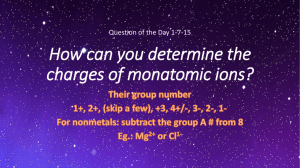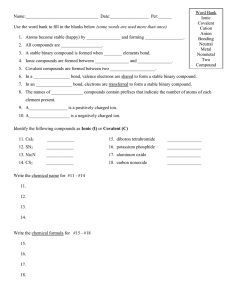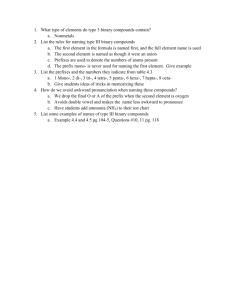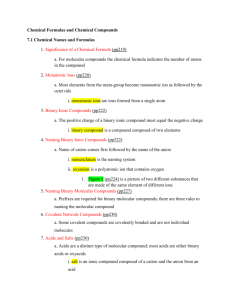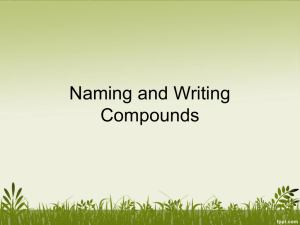Chapter 7: Chemical Formulas and Chemical Compounds
advertisement
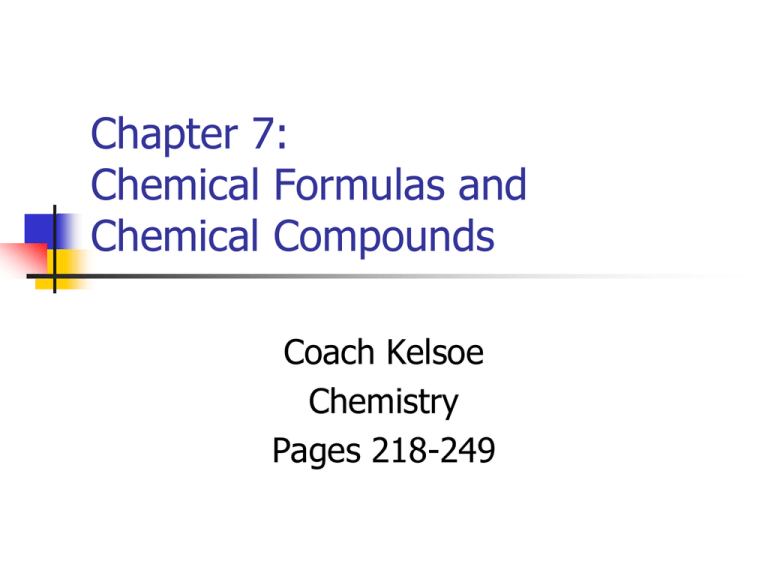
Chapter 7: Chemical Formulas and Chemical Compounds Coach Kelsoe Chemistry Pages 218-249 Chapter 7-1: Chemical Names and Formulas Coach Kelsoe Chemistry Pages 219-231 Section 7-1 Objectives Explain the significance of a chemical formula. Determine the formula of an ionic compound formed between two given ions. Name an ionic compound given its formula. Using prefixes, name a binary molecular compound from its formula. Write the formula of a binary molecular compound given its name. Chemical Names and Formulas The total number of natural and synthetic chemicals runs in the millions, so often times it is easier to give chemicals their own names: Calcium carbonate – Limestone Sodium chloride – Table salt Dihydrogen monoxide – Water Sodium bicarbonate – Baking soda Chemical Names and Formulas The only problem with common names is that you can’t tell about its chemical composition. There is a systematic method for naming compounds and for writing chemical formulas. Ionic Compounds vs. Molecular Compounds Ionic compounds are compounds that are held together by ionic bonds. Molecular compounds are compounds that are held together by covalent bonds. So how do you know the difference? Electronegativity values, silly! Significance of a Chemical Formula A chemical formula indicates the relative number of atoms of each kind in a chemical compound. For a molecular compound, the chemical formula reveals the number of atoms of each element contained in a single molecule of the compound. Significance of a Chemical Formula The chemical formula for an ionic compound represents one formula unit–the simplest ratio of the compound’s cations and anions. Note the parentheses to identify the anion as a unit. The subscript 3 refers to the entire unit. With no subscript, assume one atom. Monatomic Ions By gaining or losing electrons, many maingroup elements form ions with noble-gas configurations. Group 1 elements tend to form 1+ cations, group 2 elements tend to form 2+, etc. Ions formed from a single atom are known as monatomic ions. Group 17 elements tend to form 1- anions. Monatomic Ions Not all main-group elements readily form ions. Rather than gaining or losing electrons, carbon and silicon atoms form covalent bonds. Tin and lead tend to lose the two electrons in their p orbitals, but retain the two in the s orbital. What charge would they have? Elements from the d-block form 2+, 3+, or in a few cases 1+ or 4+ cations. Naming Monatomic Ions Monatomic cations are identified simply by the elements name, followed by “cation.” Potassium cation Magnesium cation Naming monatomic anions requires dropping the ending of the element’s name and replacing it with the suffix –ide. Chlorine Chloride anion Nitrogen Nitride anion Some Common Monatomic Ions Main-group elements 1+ Lithium 2+ 3+ Li+ Sodium Na+ Magnesium Potassium K+ Calcium Mg2+ Aluminum Ca2+ Rubidium Rb+ Strontium Sr2+ Cesium Cs+ Barium Ba2+ 1- 2- Fluoride F- Chloride Cl- Sulfide Bromide Br- Iodide I- Oxide Al3+ 3O2- Nitride S2- N3- Some Common Monatomic Ions d-block elements 1+ 2+ 3+ 4+ Copper(I) Cu+ Cadmium Cd2+ Chromium(III) Cr3+ Lead(IV) Silver Ag+ Chromium(II) Cr2+ Iron(III) Fe3+ Vanadium(IV) Cobalt(II) Co2+ Lead(III) Pb3+ Tin(IV) Copper(II) Cu2+ Vanadium(III) Iron(II) Fe2+ Lead(II) Pb2+ Manganese(II) Mn2+ Mercury(II) Hg2+ Nickel (II) Ni2+ Tin(II) Sn2+ Vanadium(II) Zinc V2+ Zn2+ V3+ Pb4+ V4+ Sn4+ Binary Ionic Compounds Compounds composed of two different elements are known as binary compounds. In a binary compound, the total numbers of positive charges and negative charges must be equal! Therefore the formula for such a compound can be written given the identities of the compound’s ions. For example: magnesium bromide. We do NOT put the charges in the final formula! A Quick Math Review Subscripts are the small numbers written to the right of an element’s symbol. Coefficients are the large numbers written to the left of an element’s symbol. O2, H2O, CH4O 2O2, 5H2O, 19CH4O With polyatomic ions, the subscripts are multiplied: (SO4)2, (HSO4)3, (H2PO4)4 “Crossing Over” As an aid to determining subscripts in formulas for ionic compounds, the positive and negative charges can be “crossed over.” Al3+ O2Al2O3 We can check to make sure this is correct by multiplying the original charge by the new subscripts to make sure the number is the same for both the atoms in the molecule. Naming Binary Ionic Compounds The nomenclature, or naming system, of binary ionic compounds involves combining the names of the compound’s positive and negative ions. For most simple ionic compounds, the ratio of the ions is not indicated in the compound’s name because it is understood based on the relative charges of the compound’s ions. Al2O3 Aluminum oxide Sample Problem 1 Write the formula for the binary ionic compound formed between calcium and iodine. 2+ Ca I CaI2 Write the formula for the binary ionic compound formed between calcium and sulfur. 2+ Ca S2 CaS Sample Problems 1 Write formulas for the binary ionic compounds formed between the following elements: Potassium and iodine Magnesium and chlorine Sodium and sulfur Aluminum and sulfur Aluminum and nitrogen Sample Problems 1 Name the binary ionic compounds indicated by the following formulas: AgCl ZnO CaBr2 SrF2 BaO CaCl2 The Stock System of Nomenclature Some elements, such as iron, form two or more cations with different charges. To distinguish the ions formed by such elements, the Stock system of nomenclature is used. This system uses a Roman numeral to indicate an ion’s charge. The numeral is enclosed in parentheses and placed immediately after the metal name. Fe2+ iron(II) Fe3+ iron(III) The Stock System of Nomenclature Names of metals that commonly form only one cation do not include a Roman numeral. Na+ Sodium Ba2+ Barium There is no element that commonly forms more than one monatomic anion. Naming a binary ionic compound according to the Stock system is done as so: CuCl2 copper(II) chloride CuF3 copper(III) fluoride Sample Problem 2 Write the formula and give the name for the compound formed by the ions Cr3+ and F-. CrF3 Chromium(III) fluoride Sample Problems 2 Write the formula and give the name for the following compounds formed between the following ions: Cu2+ and BrFe2+ and O2Pb2+ and ClHg2+ and S2Sn2+ and FFe3+ and O2- CuBr2; copper(II) bromide FeO; iron(II) oxide PbCl2; lead(II) chloride HgS; mercury(II) sulfide SnF2; tin(II) fluoride Fe2O3; iron(III) oxide Sample Problems 2 Give the names for the following compounds: CuO CoF3 SnI4 FeS Copper(II) oxide Cobalt(III) fluoride Tin(IV) iodide Iron(II) sulfide Compounds Containing Polyatomic Ions The list of polyatomic ions and their charges can be found on page 226 in your text. All but the ammonium ion are negatively charged and most are oxyanions, polyatomic ions that contain oxygen. It isn’t uncommon for two oxyanions to be formed from the same two elements: Nitrogen and oxygen form nitrite and nitrate. Compounds Containing Polyatomic Ions When naming compounds containing oxyanions, the most common ion is given the ending –ate. The ion with one less oxygen atom is given the ending –ite. NO2 Nitrite NO3 Nitrate If two elements form more than two different oxyanions, an anion with one less oxygen than the –ite anion is given the prefix hypo-. ClO2 Chlorite ClO Hypochlorite Compounds Containing Polyatomic Ions An anion with more oxygen than the –ate anion is given the prefix per-. Compounds containing polyatomic ions are named in the same manner as binary ionic compounds. AgNO3 Silver nitrate; AgNO2 Silver nitrite When more than one polyatomic ion is present in a compound, use parentheses. Al2(SO4)3 Aluminum sulfate Sample Problems 3 Write the formula for tin(IV) sulfate. Sn4+ SO42Sn(SO4)2 Write the formulas for the following ionic compounds: Sodium iodide Calcium chloride Potassium sulfide Lithium nitrate Copper(II) sulfate NaI CaCl2 K2S LiNO3 CuSO4 Sample Problems 3 Give the name for the following compounds: Ag2O Ca(OH)2 KClO3 NH4OH FeCrO4 KClO Silver oxide Calcium hydroxide Potassium chlorate Ammonium hydroxide Iron(II) chromate Potassium hypochlorite Naming Binary Molecular Compounds Unlike ionic compounds, molecular compounds are composed of individual covalently bonded units, or molecules. Chemists use two nomenclature systems to name binary molecules: the Stock system and the prefix system. The prefix system uses numerical prefixes to identify the number of atoms in the molecule. Naming Binary Molecular Compounds For example, CCl4 is called carbon tetrachloride. The prefix tetra- means “four.” The prefix will come before both molecules. The prefix mono- can sometimes be left off. 1 2 3 4 5 monoditritetrapenta- 6 7 8 9 10 hexaheptaoctanonadeca- Rules for Naming Binary Molecular Compounds 1. 2. The less-electronegative element is given first. It is given a prefix only if it contributes more than one atom to a molecule of the compound. The second element is named by combining (a) a prefix indicating the number of atoms contributed by the element, (b) the root of the name of the second element, and (c) the ending –ide. With few exceptions, the ending –ide indicates that a compound contains only two elements. Rules for Naming Binary Molecular Compounds 3. The o or a at the end of a prefix is usually dropped when the word following the prefix begins with another vowel, e.g., monoxide or pentoxide. Tetraphosphorus decoxide P4O10 Phosphorus comes first because it is less electronegative than oxygen. The order of nonmetals in binary compound names and formulas- C, P, N, H, S, I, Br, Cl, O, F. Sample Problem 4 Give the name for As2O5. Diarsenic pentoxide Name the following binary molecular compounds: SO3 ICl3 PBr5 Sulfur trioxide Iodine trichloride Phosphorus pentabromide Sample Problem 4 Write the formula for oxygen difluoride. OF2 Write formulas for the following compounds: Carbon tetraiodide Phosphorus trichloride Dinitrogen trioxide CI4 PCl3 N2O3 Acids and Salts Most acids used in the laboratory can be classified as either binary acids or oxyacids. Binary acids are acids that consist of two elements, usually a hydrogen and one of the halogens – F, Cl, Br, or I. Oxyacids are acids that contain hydrogen, oxygen, and a third element, usually a nonmetal. Acids and Salts Acids were first recognized as a specific class of compounds based on their properties in solutions of water. Consequently, in chemical nomenclature, the term acid usually refers to a solution in water of one of these special compounds rather than to the compound itself. For example, hydrochloric acid refers to a water solution of the molecular compound hydrogen chloride, HCl. Acids and Salts Many polyatomic ions are produced by the loss of hydrogen ions from oxyacids. An ionic compound composed of a cation and the anion from an acid is often referred to as a salt. Table salt, NaCl, contains the anion from hydrochloric acid. Calcium sulfate, CaSO4, is a salt containing an anion from sulfuric acid. Acids and Salts Some salts contain anions in which one or more hydrogen atoms from the acid are retained. Such anions are named by adding the word hydrogen or the prefix bi- to the anion name. The best known such anion comes from carbonic acid, H2CO3.
